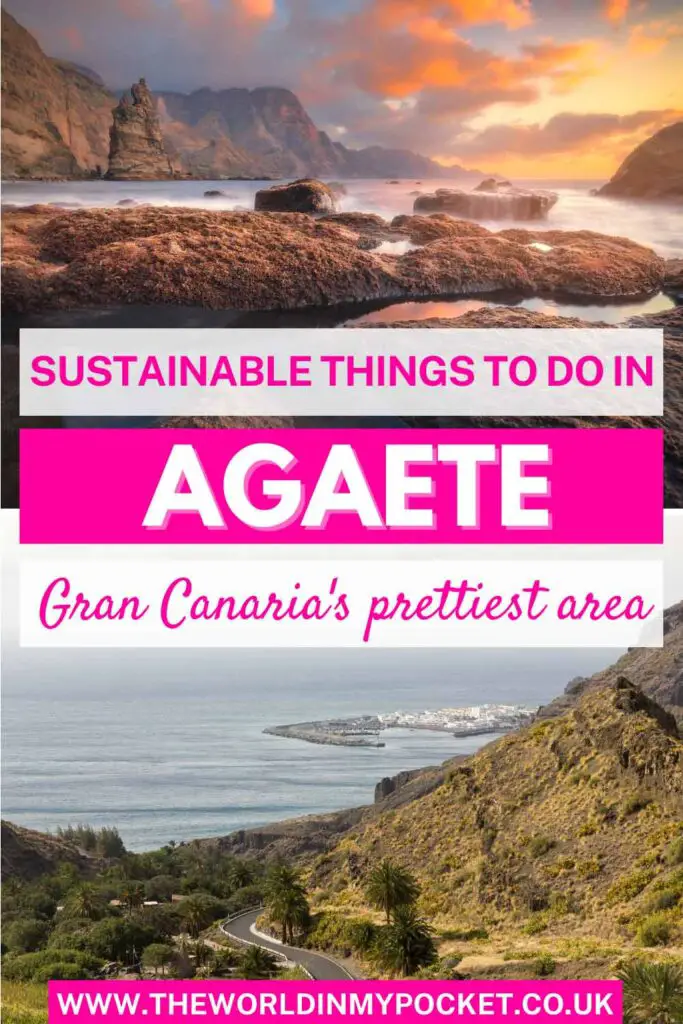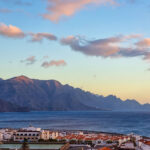Agaete was one of my favourite areas in Gran Canaria. Located in the north of the island, Agaete is the perfect place to visit if you want to escape the crowds, learn about Gran Canaria’s heritage whilst still enjoying the fantastic beeches and weather that the island is so well known for. There are plenty of things to do in Agaete that will help keep your trip to Gran Canaria sustainable.
About Agaete

Agaete is a wonderful village located in the less touristy part of Gran Canaria. In my opinion, Agaete is one of the most beautiful areas of Gran Canaria. In Agaete it’s not just the nature that is spectacular, but also the town itself, with a historic quarter and a XIX century architecture. Here is where mountains meet the sea creating some dramatic scenery. The area is perfect for hikers, cyclists, as well as people who just want to relax by the beach.
Did you know that Agaete and its valley are the only places where coffee is grown in Europe? Or that here you will find one of the most surprising necropolises in the world?
Let me tell you why visiting Agaete makes a sustainable experience in Gran Canaria in the lines below.
Where to Stay in Agaete

Occidental Roca Negra is an eco-friendly hotel with sustainable practices, where you can enjoy the five star treatment whilst reducing your travel carbon footprint. The first thing you will notice about the Occidental Roca Negra hotel is the way it has been built, on the side of the rocks, purposely and therefore not affecting the landscape view. As you approach the hotel from the road you will only notice the reception level, which blends in with the local architecture of the village.
The rooms are spacious, with a refreshing exotic design including green and brown elements, real plants, and subtle palm tree leaves decorations. There is even a relaxing egg hanging chair which can be moved to the balcony. The hotel uses eco-friendly toiletries, has a key-card controlled electricity, as well as the optional opting out from daily cleaning and towel change.
To support spending time in nature, the hotel offers bike rentals, and has a secure bicycle parking for guests who arrive here cycling.
The hotel features two large outdoor pools and a jacuzzi, as well as a wellness center where you can relax after a long day of hiking or cycling. The rooftop terrace is a fantastic place to spend the evening, watching the sunset, sipping from a cocktail.
You can check the hotel’s reviews on TripAdvisor by clicking here, or the latest rates directly on Booking.com
Eco-Friendly Things to Do in Agaete
Take a Dip and Swim in the Las Salinas de Agaete Natural Pools

One of the most spectacular places in Agaete are the natural volcanic pools that are filled by the water of the ocean. The pools are quite rustic, with rugged terrain and sharp rocks with traces of salt on them. Each has a metal step ladder, for easy access and exit in and out of the pools. They are quite deep, but the high volume of salt in the water will keep you afloat.
I loved spending time here. Even if the ocean was quite rough and the waves would crash violently into the rocks, the pools were protected and only the mist would come over. Which, on a hot July day, provided a great way to cool down.
The water inside the pools will feel cold initially, but once you swim around a bit, your body will get used to it and you’ll soon feel comfortable.
Access to the natural pools Las Salinas de Agaete is free of charge. Unless you are coming here on a weekend, there won’t be many people around. I had one of the pools entirely to myself.
Learn About Gran Canaria’s Heritage at the Maipes Archaeological Park

Maipes Archaeological Park is a very interesting place to see. My visit here was supposed to be for one hour, but I ended up staying for so much longer. It was fascinating to learn how the ancient inhabitants of the island made use of this inhospitable terrain to bury their dead.
Gran Canaria is a very small island, which meant that the Ancient Canarians had to make clever use of the terrain. As a lot of the island has been covered by ash and unfriendly lava rocks, they chose these areas to create cemeteries. Maipes, the name of the site, is a Canarian word that derived from “malpais”, which means badland. This was how this rocky, lava field was referred to.
There are over 700 tombs inside the petrified area, of which, only a few are visible to the naked eye. Maipes is one of the largest aboriginal cemeteries on the Canary Islands. To make a tomb, the ancient Canarians would remove the loose stones then level out the ground underneath to the size of the deceased. The body was then laid out inside a vault made out of large stones that were placed around it, that weren’t touching the body. The tomb was then sealed with more stones, and a tumuli would be built on top. Depending on the (living) status of the deceased, the tumuli would be larger and taller.
The Maipes Archaeological Park is accessible, with boarded walkways making it accessible for people with restricted mobility too . The entrance fee to the site is 3 euros.
Swim Under the Tail of the Dragon

Gran Canaria is famous for its golden sand beaches, the Dunes of Maspalomas, as well as the luxury resorts on the south of the island. The north offers very different scenery and a much more intimate experience.
The beach in Puerto de las Nieves is small and narrow, with rough black volcanic rocky sand, but offers access to one of the most incredible swimming environments: The Tail of the Dragon.
To learn more about what the Tail of the Dragon is, we have to go back 14 million years, when Gran Canaria was formed by a series of volcanic explosions. The lava divided the island and created the deep valleys that cross through the cliffs, forming the dramatic landscape we see today.
One of these spectacular rock formations, reaching 1000 meters above the sea level, are known locally as the Tail of the Dragon. And, when you look at it from the rooftop terrace of Occidental Roca Negra Hotel, you’ll will see why.
Swimming below the Trail of the Dragon is an incredible experience. The high peak rocks descend sharply into the crystal clear water, giving the perfect backdrop for a unique swim experience.
Visit a Sustainable Coffee Finca

I have always been fascinated by coffee. I have visited coffee plantations in all corners of the world, from Central America to Africa, to Asia. I have seen coffee growing on the slopes of Kilimanjaro, shaded by banana trees, on the hills in El Salvador, and in the thick jungle of the central highlands in Vietnam.
When I found out that Gran Canaria is the only place that commercially grows coffee in Europe, I had to visit a finca and learn more about the local beans. The coffee shrubs in Gran Canaria grow under the shade of the vines, mango trees or jasmine plants, to be protected by the harsh sun. The coffee loves warm weather, but can’t tolerate direct sunlight, so the success formula to grow the shrubs is to make sure that they have shade. This is the guidance for coffee growers that is followed the world over.
The coffee in Gran Canaria is surprisingly light, with a lovely fragrant flavour and a moderate acidity. It is a perfect brew for people who like a mild coffee taste.
There are 40 fincas around Agaete, where you can see how coffee grows and taste a cup of Gran Canaria Coffee. Most of the coffee here is grown organically, without pesticides, harvested and processed manually. A great place to experience a Gran Canarian coffee tasting is Finca La Laja.
Enjoy a Local Wine Tasting at Casa Romantica

Casa Romantica is a beautiful family run restaurant that hosts a museum dedicated to all the provinces of Gran Canaria, in the back garden. The restaurant is sustainable, and uses their own home grown produce to prepare food. The concept of the restaurant is to showcase the Canarian flavours through a beautiful degustation menu.
Casa Romantica is located deep in the ravine, and is part of the Los Berrazales vineyard. They are producing wine in an artisanal way, using the traditional agricultural and winemaking tradition of Agaete. Their wines have won numerous awards in Gran Canaria, and their labels have been designed by the local famous artist Pepe Damaso.
During the wine tasting we were served three different ones, alongside a lovely selection of artisanal locally produced cheeses. We started with a fruity sweet wine, followed by a dry blend of white Listan and Malvasia grapes. The tasting ended with an oaky red Roble made with Tintilla de Rota grapes.
The tasting took place on the restaurant’s terrace, under the beautiful frangipani trees which in June were in full bloom.
Eat Fish at a Local Seafront Restaurant in Puerto de las Nieves

Puerto de las Nieves is a whitewashed fishermen village located on the coast, 15 minutes away from the center of Agaete. This is where the beaches of Agaete are located. Also, here is where you can have the best fish dishes, cooked in restaurants with a sea view.
Most of the restaurants in Puerto de las Nieves cater to locals, and serve fresh fish and seafood dishes as well as tapas. The prices are very affordable, especially if you go for the menu del dia which includes a three course meal, a drink and a coffee for less than 10 euros.
The local dish in Puerto de las Nieves is the caldo de pescado, a delicious, warming fish soup.
Like it? Pin it!

Disclaimer: Some of the links on this website are “affiliate links.” This means that if you click on the link and do a purchase, I will receive an affiliate commission at no extra cost for you. This helps me keep my website running and continue to share my travelling knowledge with you. I thank you for booking your flights or hotels using the links on my website. Regardless, I only recommend products or services I use personally and believe will add value to my readers.





The water here looks incredible! I’d be happy just to go swimming everyday
Wonderful information, thank you for introducing me to Agete and the Gran Canaria. The Maipes Archaeological Park sounds amazing. Incredible landscape and interesting history.
Agaete looks so charming! I would love to return to Spain and visit. Thank you for the insightful information.
WOW! The volcanic pools and the Dragons Tail look amazing! Would also love to visit that winery. A great read, may have to add Agaete to the travel list.
Cheers!
Wow, the landscape looks so inviting! Not to mention how clear and blue the water looks in some of your photos. I guess I know where I’m traveling to next!